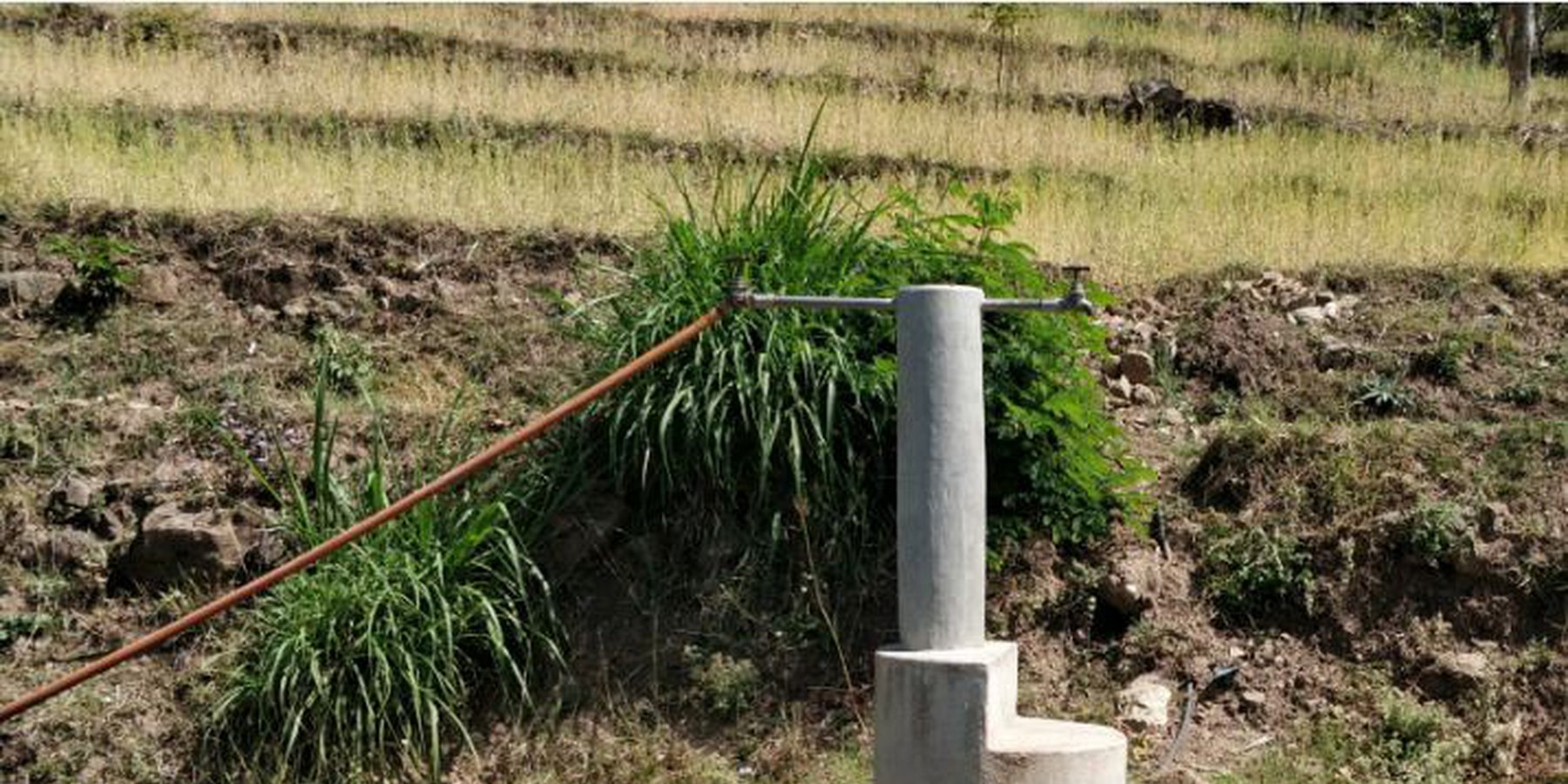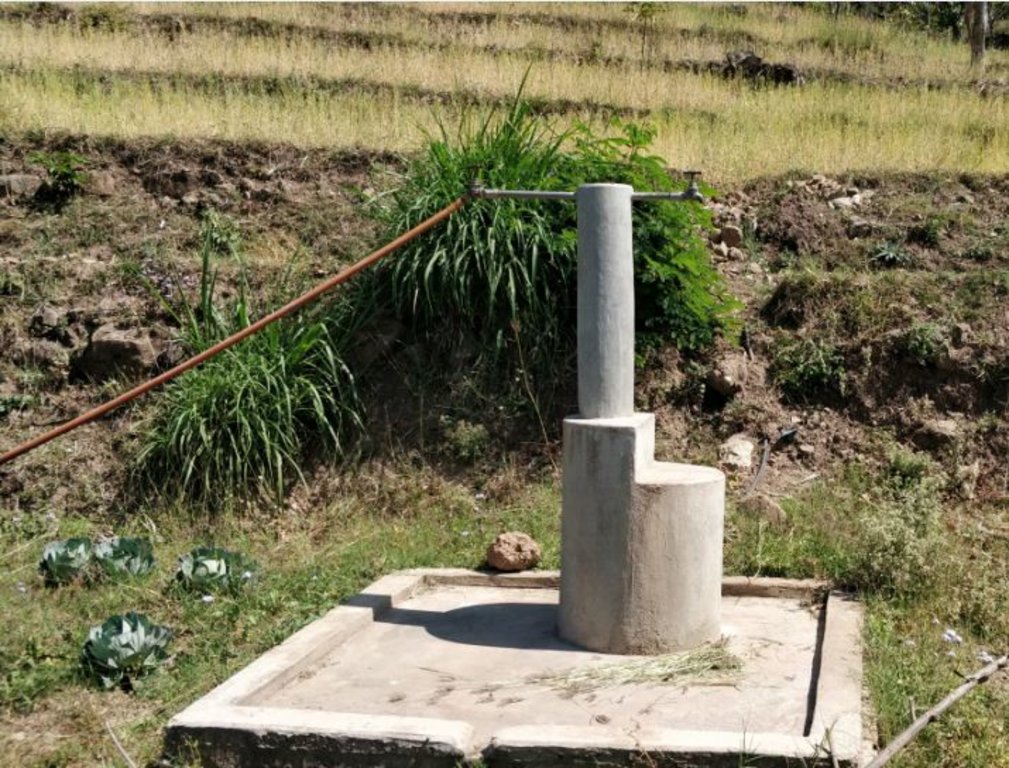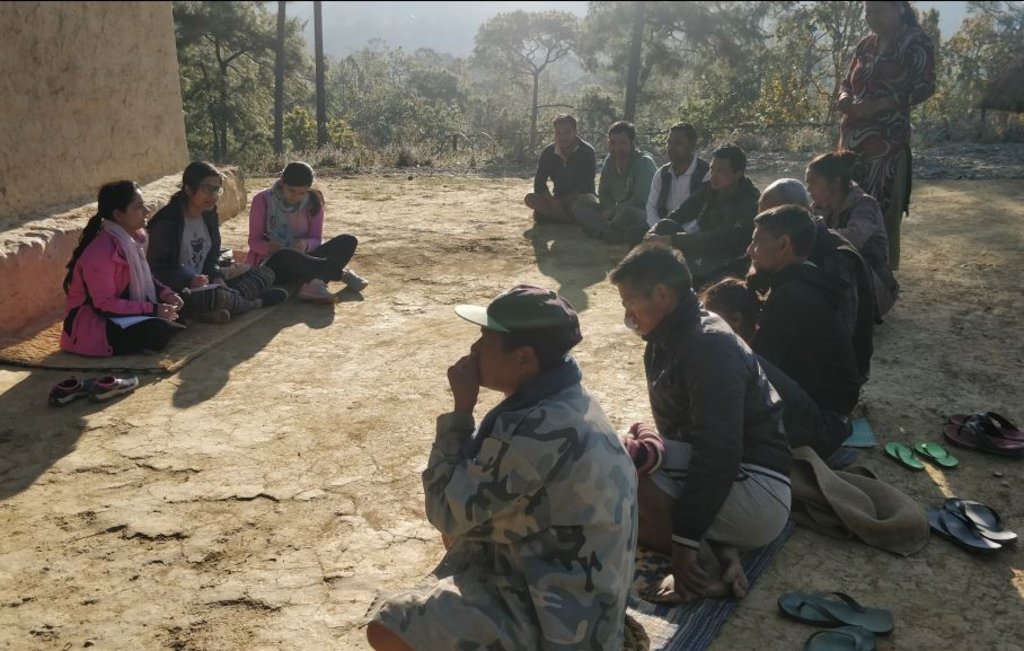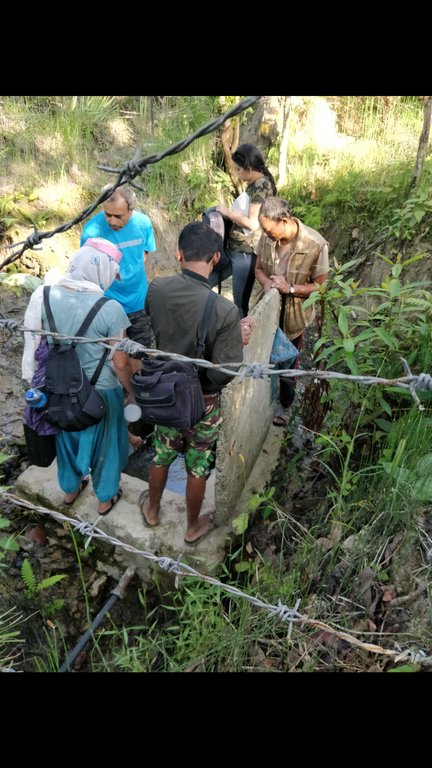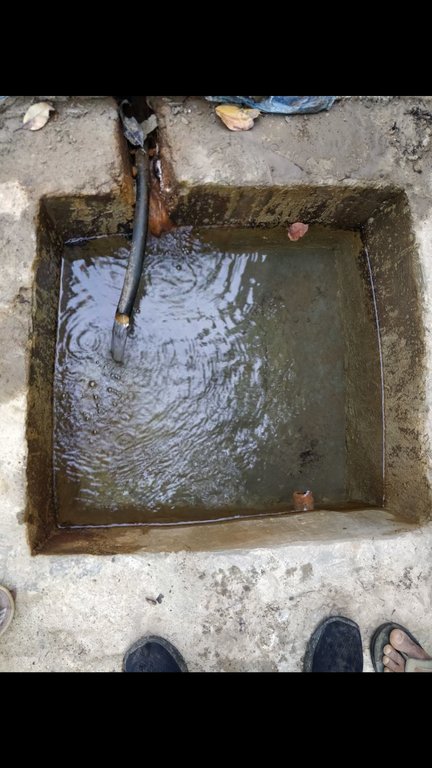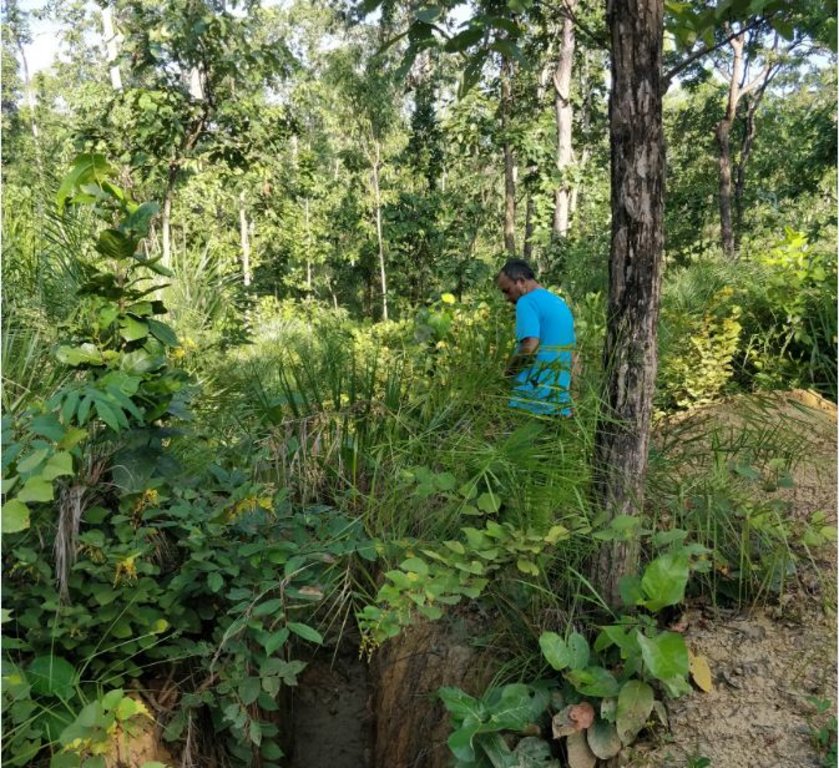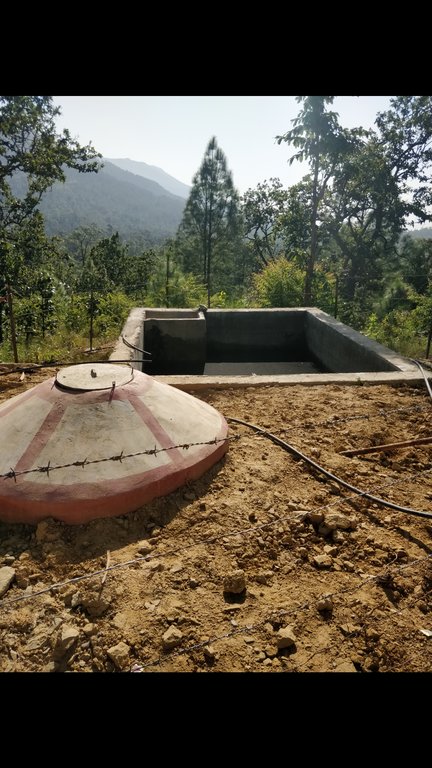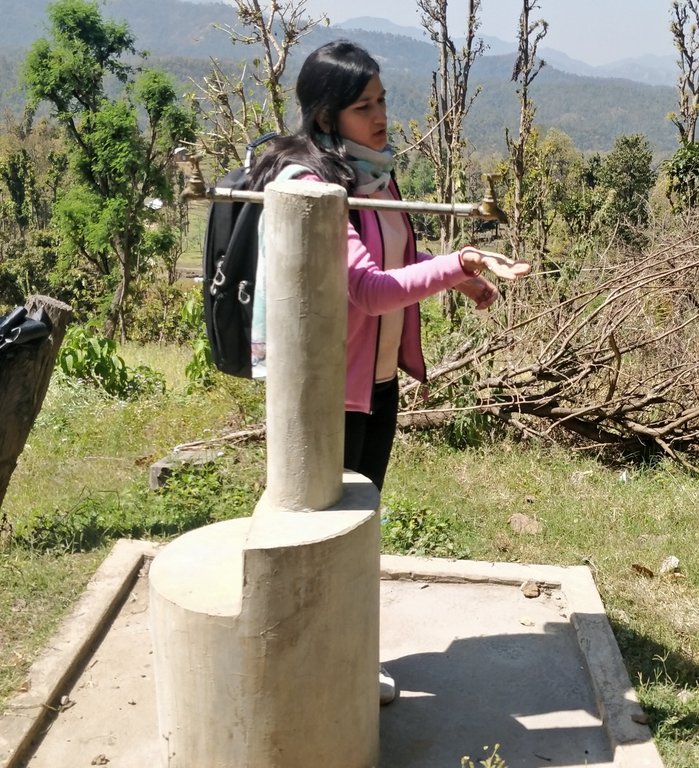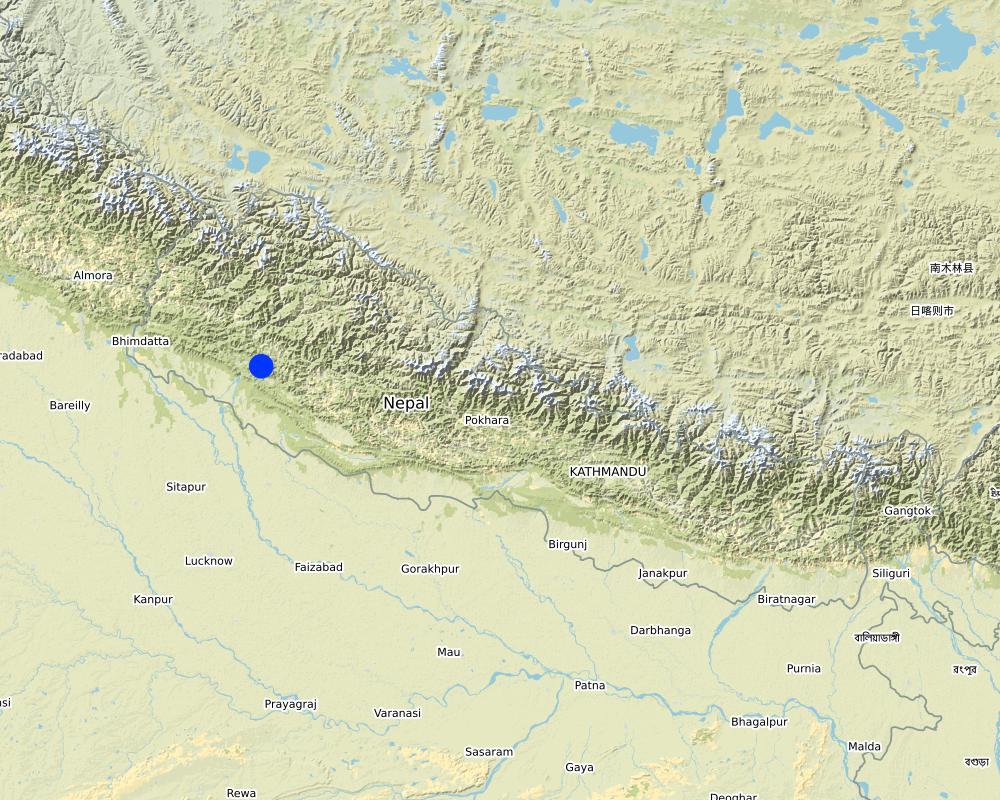Gravity-Fed Multiple Use Water System (MUWS) : Odaltaal [النيبال]
- تاريخ الإنشاء:
- تحديث:
- جامع المعلومات: Jhuna Kattel
- المحرر: –
- المُراجع: Renate Fleiner
Odaltaal Ghaito
technologies_5182 - النيبال
عرض الأقسام
توسيع الكل طي الكل1. معلومات عامة
1.2 تفاصيل الاتصال بالأشخاص الرئيسيين لمصدر المعلومات والمؤسسات المشاركة في تقييم وتوثيق التقنية
الشخص (الأشخاص) الرئيسي لمصدر المعلومات
Water User:
Sunar Kopila
النيبال
اسم المشروع الذي سهّل توثيق/تقييم التقنية (إذا كان ذلك على صلة)
Prospects and challenges of water use systems as climate adaptive option for sustainable water management in Himalayan Regionاسم المؤسسة (المؤسسات) التي سهلت توثيق/تقييم التقنية (إذا كان ذلك على صلة)
Kathmandu University (KU) - النيبال1.3 الشروط المتعلقة باستخدام البيانات الموثقة من خلال WOCAT
يوافق جامع المعلومات والشخص (لاشخاص) الرئيسي لمصدر المعلومات على الشروط المتعلقة باستخدام البيانات الموثقة من خلال WOCAT:
نعم
1.4 إعلان بشأن استدامة التقنية الموصوفة
هل التقنية الموصوفة هنا تمثل مشكلة فيما يتعلق بتدهور الأراضي، بحيث لا يمكن إعلانها تقنية مستدامة لإدارة الأراضي؟:
كلا
التعليقات:
The technology used serves as a source of providing water for drinking and other multiple uses; such that it acts as a means to conserve and manage water resources rather than degrade them.
2. وصف تقنيةالإدارة المستدامي للأراضي
2.1 وصف مختصر للتقنية
تعريف التقنية:
Water from source in hill top is collected in a small reservoir (to preserve natural source), then passes onto a Reservoir Tank (RVT) / Ferro-Cement Tank / "Ghaito" for drinking water with a capacity of 4000L. When the RVT gets filled, water overflows, is collected in another concrete irrigation pond (10,000L) for irrigation. From the ferro-cement tank (Ghaito) and concrete irrigation pond, two pipelines are fed and water supplied into individual tap-system or MUWS tap towers for multiple purposes.
2.2 وصف تفصيلي للتقنية
الوصف:
The technology is applied in a natural environment, i.e. natural water source. The source of water is a natural source of water that sits atop a small hill which is owned by the government. From the source, water is collected in RVT ( for drinking water) and concrete irrigation pond ( for irrigation). PVC pipes are fed onto the tanks to distribute the water for multiple purposes to 4 MUWS tap towers or tap systems or "Thaado". These MUWS tap towers consist of two faucets each- one for drinking and the other for irrigation and other purposes.The major purposes of this technology are to supply clean water for drinking and other multiple purposes through a cheap, effective and simple system. The natural source of water is locally maintained. Operation and maintenance works are not mandatory, however the locals are responsible for maintaining it should the need arise. The system was financed through a public-private-partnership (PPP) program; out of which some amount was funded by a Non-Governmental Organization (NGO)- Sundar Nepal ( NPR. 2,77,000 ), some amount by the Village Development Committee (VDC)- (NPR. 2,63,000), and the remaining amount was collected by a locals’ group (NPR. 60,000). For establishing the system, labor and construction materials were needed for building the tanks and pipeline systems. For the maintenance, manual labor is necessary. The quality of the water that is supplied to the households is good and the quantity seems sufficient for the 19 households. Sustainable use of water resources through a MUWS system, cheap and effective way to conserve water resources, ensuring availability of clean water even through dry seasons are some of the technology's advantages. Similarly, clean water, more water for irrigation for vegetable farming, simplifying day-to-day life are some of the strengths of the technology. Dislikes could be the limited availability of water during the dry season and that out of 4 systems only 2 are in operation and the other ones are in a non-working condition.
Management system in place for MUWS:
A separate committee is set up for the smooth operation of the system, which consists of 20 members- 10 males and 10 females. The head of the committee is Mrs. Kopila Sunar. The committee conducts a monthly meeting to discuss the problems and need of maintenance. During the initial setup, the connection of pipelines from the tap systems to the reservoir tanks was, however, done with the contribution of the locals. Every month, each family from the 19 households contributes NPR. 100 ( One Hundred Rupees) , which goes to a fund that is set up for the times of need. The labor contribution by the people of the VDC was dependent upon the number and availability of family members in the household. Similarly, the use of the MUWS system and water from it is also dependent upon the availability of family members. Little to no maintenance was done to the system till now from 2075 B.S. ( 1 years) . Equal number of male and female members are in the committee dedicated to the MUWS system.
2.3 صور التقنية
2.5 البلد/المنطقة/المواقع التي تم تنفيذ التقنية فيها والتي يغطيها هذا التقييم
البلد:
النيبال
المنطقة/الولاية/المحافظة:
Province-6, Mid-Western Development Region
مزيد من التفاصيل حول الموقع:
Kunathari VDC-10, Odaltaal
حدد انتشار التقنية:
- يتم تطبيقها في نقاط محددة/ تتركز على مساحة صغيرة
هل يقع موقع/مواقع التقنية في منطقة محمية بشكل دائم؟:
كلا
Map
×2.6 تاريخ التنفيذ
اذكر سنة التنفيذ:
2018
2.7 إدخال التقنية
حدد كيف تم إدخال التقنية:
- من خلال المشاريع/ التدخلات الخارجية
التعليقات (نوع المشروع، الخ):
Sundar Nepal- a non-governmental organization (NGO) helped with Odaltaal Multiple Use Water Systems
3. تصنيف تقنية الإدارة المستدامي للأراضي
3.1 الغرض الرئيسي ( الأغراض الرئيسية) للتقنية
- تحسين الإنتاج
- الحد من تدهور الأراضي ومنعه وعكسه
- التكيف مع تغير المناخ/الظواهر المتطرفة وآثارها
- خلق أثر اقتصادي مفيد
- improve water security and increase efficient use at a household level
3.2 نوع (أنواع) استخدام الأراضي الحالية حيث يتم تطبيق التقنية

الأراضي الزراعية
- زراعة سنوية
- زراعة معمرة (غير خشبية)
الزراعة السنوية - حدد المحاصيل:
- الحبوب - الشعير
- الحبوب - الذرة
- الحبوب - الأرز (في الأراضي المرتفعة)
- الحبوب - قمح (ربيعي)
- الحبوب - قمح (شتوي)
الزراعات المعمرة (غير الخشبية) - حدد المحاصيل:
- أريكا
- الموز/موز الهند/الأباكا
- قصب السكر
عدد مواسم الزراعة في السنة:
- 3
حدد:
The water used for irrigation is used in fields for 2-3 cycles of crop growing (annual) like rice, maize and barley and into kitchen-farming/tunnel farming (perennial) where vegetables grown are cucumber, tomatoes, chilli, bitterguard, peas, etc.
هل يتم ممارسة الزراعة البينية؟:
كلا
هل تتم ممارسة تناوب المحاصيل؟:
نعم
إذا كانت الإجابة بنعم، حدد:
Rice, Maize and Wheat are cycled according to the seasons.

غير ذلك
حدد:
Drinking Water
ملاحظات:
Drinking water used directly from the tap systems. Some boil it but most of them use it straight from the tap systems and consume without filtration.
التعليقات:
Irrigation and Multiple Uses: The locals use the technology in order to irrigate their cropland so that the plant productivity is increased. As well, the introduction of this technology has opened up doors to new possibilities like construction of tunnels ( green houses) so that the locals can grow seasonal and off-seasonal vegetables in their backyards. Animal husbandry has also been an increasing practice. Human uses like washing, cooking, cleaning, bathing, etc are amply sufficient due to adequacy of water from this technology.
3.3 هل تغير استخدام الأراضي نتيجة لتنفيذ التقنية؟
هل تغير استخدام الأراضي نتيجة لتنفيذ التقنية؟:
- نعم (يرجى ملء الأسئلة أدناه فيما يتعلق باستخدام الأراضي قبل تنفيذ التقنية)

الأراضي الزراعية
- زراعة سنوية
- زراعة معمرة (غير خشبية)
الزراعة السنوية - حدد المحاصيل:
- الحبوب - الشعير
- الحبوب - الذرة
الزراعات المعمرة (غير الخشبية) - حدد المحاصيل:
- الموز/موز الهند/الأباكا
هل يتم ممارسة الزراعة البينية؟:
كلا
هل تتم ممارسة تناوب المحاصيل؟:
كلا
التعليقات:
Before the introduction of the technology, the land productivity was minimal. Water for human uses like bathing, cleaning, washing, cooking, etc. were scarce; especially during the dry seasons. No green houses were constructed. They used to rear very few cattle.
3.4 إمدادات المياه
أخرى (مثل ما بعد الفيضانات):
- Natural source (Mool) of water in foliage atop a hill
التعليقات:
The supply of water comes from a natural source ( 'mool' in local language) , where a small enclosure is constructed so that the source is preserved and water is amply supplied to the ferrocement RVT for drinking purposes ( 'Ghaito' in local language) and concrete irrigation pond for irrigation purposes.
3.5 مجموعةالإدارة المستدامة للأراضي التي تنتمي إليها هذه التقنية
- حصاد المياه
- إدارة الري (بما في ذلك إمدادات المياه والصرف الصحي)
- إدارة المياه الجوفية
- Gravity Fed Multiple Use Water System (MUWS) , New Scheme
3.6 التدابير التقنية في مجال إلادارة المستدامة للأراضي

التدابير البنيوية
- S5: السدود، الأحواض الصغيرة، البرك
- S6: الجدران والحواجز وسياجات القش، والسياجات
- S7: معدات حصاد المياه/الإمداد/الري
- S11: غير ذلك
التعليقات:
The technology is comprised of structural measures, barbed wire fences to surround natural water source, iron lid top, cement enclosure for water source, pipes feeding onto the source, ferro-cement RVT, tap towers, faucets, concrete irrigation pond, etc.
3.7 الأنواع الرئيسية من تدهور الأراضي التي تناولتها التقنية

تدهور المياه
- (Hs): التغيير في كمية المياه السطحية
- (Hp): تدهور نوعية المياه السطحية
التعليقات:
Before setting up the technology, much of the water during dry seasons would evaporate from the natural source ( mool) and there would be scarcity of water during dry seasons. This has been addressed by the technology, where securing the natural source of water prevented evaporation and storing water in enclosed tanks helped supply water during dry seasons.
Similarly, due to no preservation of the source and no storage tanks, the water would be soiled by sediments, wastes and insects' larvae. After setting technology up, the quality of water has vastly improved as well.
3.8 منع أو حد أو عكس تدهور الأراضي
تحديد هدف التقنية فيما يتعلق بتدهور الأراضي:
- منع تدهور الأراضي
التعليقات:
The technology prevents water source degradation, improves perennial water availability, helps tackle with the effects of natural calamities like drought, etc.
4. المواصفات الفنية، وأنشطة التنفيذ، والمدخلات، والتكاليف
4.1 الرسم الفني للتقنية
المواصفات الفنية (المتعلقة بالرسم الفني):
Source: Natural (mool) atop a small hill, secured by wire fences and preserved with concrete and metal lid ( to prevent evaporation).
Water from source collected in Ferro-Cement Tank (RVT) / "Ghaito" in local language, with capacity 4000Ltrs.
Water overflows from RVT into an Irrigation Pond (Open Top, Concrete) with capacity 10,000Ltrs.
PVC Pipes leave the RVT and Pond into 4 MUWS Towers ("Thaado" in local language) to serve 19 households.
One faucet supplies drinking water from RVT and next faucet supplies water for irrigation and other multiple purposes (drip irrigation, tunnel farming, etc.).
4.2 معلومات عامة بخصوص حساب المدخلات والتكاليف
حدد كيفية احتساب التكاليف والمدخلات:
- حسب مساحة تنفيذ التقنية
الإشارة إلى حجم ووحدة المساحة:
5-6 dhurs
في حالة استخدام وحدة مساحة محلية، قم بالإشارة إلى عامل التحويل إلى هكتار واحد (على سبيل المثال، 1 هكتار = 2.47 فدان): 1 هكتار =:
1 ha = 590 dhurs
عملة أخرى/ عملة وطنية (حدد):
NPR
إذا كان ذا صلة، وضح سعر الصرف من الدولار الأمريكي إلى العملة المحلية (على سبيل المثال، 1 دولار أمريكي = 79.9 ريال برازيلي): 1 دولار أمريكي =:
110,0
اذكر متوسط تكلفة أجر العمالة المستأجرة في اليوم الواحد:
N/A ( voluntary labour from each household)
4.3 أنشطة التأسيس
| النشاط | التوقيت (الموسم) | |
|---|---|---|
| 1. | Enclosement for the groundwater source | Before rainy season |
| 2. | Construction of Ferro-cement tank for Drinking Water | Before rainy season |
| 3. | Construction of Concrete pond for Irrigation | Before rainy season |
| 4. | Securing the perimeter for the tanks | Before rainy season |
| 5. | Laying down the PVC pipework | Before rainy season |
| 6. | Construction of 4 individual MUWS tap towers ( Thaado in Nepalese language) | During rainy season |
| 7. | Final touch-ups, Setting up faucets, Preliminary checking | During rainy season |
التعليقات:
A total of 3 months ( roughly 90 days ) was required for the construction of the technology to be complete.
4.4 التكاليف والمدخلات اللازمة للتأسيس
| تحديد المدخلات | الوحدة | الكمية | التكاليف لكل وحدة | إجمالي التكاليف لكل مدخل | % من التكاليف التي يتحملها مستخدمو الأراضي | |
|---|---|---|---|---|---|---|
| العمالة | Voluntary by locals | 100,0 | ||||
| معدات | Irrigation Pond | 1,0 | 275000,0 | 275000,0 | 10,0 | |
| معدات | Ferrocement Tank ( Ghaito) | 1,0 | 225000,0 | 225000,0 | 10,0 | |
| معدات | Securing fences, Perimeter securing for tanks and water source | 1,0 | 50000,0 | 50000,0 | 10,0 | |
| معدات | Setting up MUWS tap towers ( Thaado in local tongue) | 4,0 | 12500,0 | 50000,0 | 10,0 | |
| معدات | PVC Pipes | 100,0 | ||||
| إجمالي تكاليف إنشاء التقنية | 600000,0 | |||||
| إجمالي تكاليف إنشاء التقنية بالدولار الأمريكي | 5454,55 | |||||
إذا تحمل مستخدم الأرض أقل من 100% من التكاليف، حدد من قام بتغطية التكاليف المتبقية:
1.Village Developmment Committee:NPR. 2,63,000 2.Sundar Nepal NGO: ~ NPR. 2,77,000 3.Water – Users : NPR. 60,000
4.5 الصيانة/الأنشطة المتكررة
| النشاط | التوقيت/الوتيرة | |
|---|---|---|
| 1. | Plan on Changing PVC pipework for a Galvanized-Iron (GI) pipe | 1 time after PVC pipes damaged by wear and tear, lime, etc |
| 2. | Plan on Construction of another Drinking Water Tank | When the one tank is not sufficient for providing enough water |
التعليقات:
Construction has been completed and technology is in use since a year only, so no maintenance works till now. However, construction of another drinking water tank and changing the PVC pipes for GI pipes is imminent in near future.
4.6 التكاليف والمدخلات اللازمة للصيانة/للأنشطة المتكررة (سنويًا)
| تحديد المدخلات | الوحدة | الكمية | التكاليف لكل وحدة | إجمالي التكاليف لكل مدخل | % من التكاليف التي يتحملها مستخدمو الأراضي | |
|---|---|---|---|---|---|---|
| العمالة | Voluntary | 100,0 | ||||
| معدات | Drinking water tank construction | 1 | 1,0 | 75000,0 | 75000,0 | 50,0 |
| معدات | Laying down GI pipesinstead of PVC Pipes | 1 | 1,0 | 50000,0 | 50000,0 | 25,0 |
| إجمالي تكاليف صيانة التقنية | 125000,0 | |||||
| إجمالي تكاليف صيانة التقنية بالدولار الأمريكي | 1136,36 | |||||
إذا تحمل مستخدم الأرض أقل من 100% من التكاليف، حدد من قام بتغطية التكاليف المتبقية:
The non-governmental organizations and government offices (Village Development Committee) have expressed an interest to help financially in the construction of another drinking water tank and GI pipes laying should the need arise.
التعليقات:
These are the expected costs should the need of such arise.
The water users' committee, along with NGO's and governmental bodies shall bear the costs in the said maintenance works.
4.7 أهم العوامل المؤثرة على التكاليف
قدم وصفا لأهم العوامل التي تؤثر على التكاليف:
The construction materials- rods, concrete, cement, bricks and Galvanized Iron (GI) pipes would cost the most
5. البيئة الطبيعية والبشرية
5.1 المناخ
هطول الأمطار السنوي
- < 250 مم
- 251- 500 ملم
- 501 - 750ملم
- 1,000-751 ملم
- 1,500-1,100 ملم
- 2,000-1,500 ملم
- 3,000-2,001 ملم
- 4,000-3,100 ملم
- > 4000 ملم
المواصفات/التعليقات على هطول الأمطار:
Monsoon/ Rainy Season 2-3 months ( June-August)
الإشارة إلى اسم محطة الأرصاد الجوية المرجعية المعنية:
Meteorological Forecasting Division, Nepal ( www.mfd.gov.np)
المنطقة المناخية الزراعية
- شبه رطبة
5.2 طوبوغرافيا
متوسط الانحدارات:
- مسطح (0-2%)
- بسيط (3-5%)
- معتدل (6-10%)
- متدحرج (11-15%)
- تلال (16-30%)
- شديدة الانحدار(31-60%)
- فائقة الانحدار (>60%)
التضاريس:
- هضاب/سهول
- أثلام مرتفعة
- المنحدرات الجبلية
- منحدرات التلال
- منحدرات في السفوح
- قاع الوادي
المنطقة الارتفاعية:
- 100-0 متر فوق سطح البحر
- 500-101 متر فوق سطح البحر
- 1,000-501 متر فوق سطح البحر
- 1,500-1,001 متر فوق سطح البحر
- 2,000-1,501 متر فوق سطح البحر
- 2,500-2,100 متر فوق سطح البحر
- 3,000-2,501 متر فوق سطح البحر
- 4,000-3,001 متر فوق سطح البحر
- > 4000 متر فوق سطح البحر
وضح ما إذا كانت التقنية مطبقة على وجه التحديد في:
- غير ذات صلة
5.3 التربة
متوسط عمق التربة:
- ضحل جدًا (0-20 سم)
- ضحلة (21-50 سم)
- متوسطة العمق (51-80 سم)
- عميقة (81-120 سم)
- عميقة جدًا (> 120 سم)
قوام التربة (التربة السطحية):
- متوسط ( طميي، سلتي)
- ناعم/ثقيل (طيني)
قوام التربة (> 20 سم تحت السطح):
- متوسط ( طميي، سلتي)
المواد العضوية في التربة السطحية:
- متوسطة (1-3%)
5.4 توافر المياه ونوعيتها
منسوب المياه الجوفية:
سطحية
توافر المياه السطحية:
جيد
نوعية المياه (غير المعالجة):
مياه شرب جيدة
تشير جودة المياه إلى:
المياه الجوفية والسطحية
هل تعتبر ملوحة الماء مشكلة؟:
كلا
هل تحدث فيضانات في المنطقة؟:
كلا
تعليقات ومواصفات أخرى بشأن نوعية المياه وكميتها:
Before the introduction of MUWS technology, the water used to be a problem during the dry seasons. However, after the technology was applied, the natural ground water source is conserved, people have been monitoring the water levels cautiously and nowadays, the water sustains the locals during the dry seasons as well.
Salinity is not a problem, but the presence of lime in the water is a problem.
5.5 التنوع البيولوجي
تنوع الأنواع:
- متوسط
تنوع الموائل:
- متوسط
التعليقات والمواصفات الإضافية بشأن التنوع البيولوجي:
Birds are abundant, new fowls are sighted regularly.Lampuchhre ( Long-tailed widowbird),Ravens,Hawks,Peacocks and peafowls,Peasants,Guinea fowls and other fowls; rarely seen before are common after setting up the technology.
Animal sighting is rare. Forests, although consisting of a few varieties of trees, like Saal ( shorea robusta), Sadhana ( Moringa) , Belauti ( Guava), Sallo ( pine tree), Aap ( Mango). very few species are abundant in a given stretch of land.
5.6 خصائص مستخدمي الأراضي الذين يطبقون التقنية
مستقر أو مرتحل:
- شبه مرتحل
التوجه السوقي لنظام الإنتاج:
- الكفاف (الإمداد الذاتي)
الدخل من خارج المزرعة:
- 10-50% من جميع الإيرادات
المستوى النسبي للثروة:
- ضعيف
أفراداً أو مجموعات:
- فرد/أسرة معيشية
مستوى المكننة:
- عمل يدوي
الجنس:
- نساء
- رجال
عمر مستخدمي الأرضي:
- أطفال
- متوسط العمر
- كبار السن
اذكر الخصائص الأخرى ذات الصلة لمستخدمي الأراضي:
Members of the community: 1:1 ratio of males to females
Age : mostly middle-aged, a few children and few elderly
Caste/ Ethnicity: Thakuri, Dalit and Janajati
Literacy: 1 person completed High – School level (+2), rest are literate ( Class 5)
Total Land Holding: < 10 ropanis of land, Human Settlement since 2040 B.S. ( since last 36+ years) in search of better opportunities and access to better services of water, roads, etc.
Total households: 19
Jobs: Males : bread- earners, construction workers, labour, farming
Females: Housewives, Farming. Most of the males in the village have been to foreign country ( India specially) for manual labour and mostly females are present in the village.
Ethnicity: Few families are of Upper- Caste: Thakuris ( as per Nepalese traditions) and most are Dalits and Janajatis, who were considered low-caste previously. The term "lower-caste" has been abolished now.
5.7 متوسط مساحة الأرض التي يستخدمها مستخدمو الأراضي الذين يطبقون التقنية
- < 0.5 هكتارا
- 0.5 - 1 هكتار
- 1 -2 هكتار
- 2 - 5 هكتار
- 5 - 15 هكتار
- 15 - 50 هكتار
- 50 - 100هكتار
- 500-100 هكتار
- 1,000-500 هكتار
- 10,000-1,000 هكتار
- > 10,000 هكتار
هل يعتبر هذا نطاقًا صغيرًا أو متوسطًا أو واسعا (في إشارة إلى السياق المحلي)؟:
- على نطاق صغير
التعليقات:
19 households occupying less than 10 ropanis of land.
(1 Hectare = 19.66 ropanis)
5.8 ملكية الأراضي، وحقوق استخدام الأراضي، وحقوق استخدام المياه
ملكية الارض:
- دولة
- The source, tanks fall under community forest area- owned by the Government
حقوق استخدام الأراضي:
- مجتمعي (منظم)
حقوق استخدام المياه:
- مجتمعي (منظم)
هل تعتمد حقوق استخدام الأراضي على نظام قانوني تقليدي؟:
كلا
حدد:
Previously, the society had a caste system in which the higher and lower caste discrimination was done and the water tainted by the lower caste ( Dalits, Janajatis) were deemed “unfit” by the upper caste ( Thakuris, Brahmins, Chhetris). However, after the abolishment of the caste system, everyone enjoys equal rights to the access to water.
5.9 الوصول إلى الخدمات والبنية التحتية
الصحة:
- ضعيف
- معتدل
- جيد
التعليم:
- ضعيف
- معتدل
- جيد
المساعدة التقنية:
- ضعيف
- معتدل
- جيد
العمل (على سبيل المثال خارج المزرعة):
- ضعيف
- معتدل
- جيد
الأسواق:
- ضعيف
- معتدل
- جيد
الطاقة:
- ضعيف
- معتدل
- جيد
الطرق والنقل:
- ضعيف
- معتدل
- جيد
مياه الشرب وخدمات الصرف الصحي:
- ضعيف
- معتدل
- جيد
الخدمات المالية:
- ضعيف
- معتدل
- جيد
التعليقات:
The access to health, education and markets along with other facilities is only accessible after a 15 minute journey to the ‘bazaar’ or market area from the village.
6. الآثار والتصريحات الختامية
6.1 الآثار التي أظهرتها التقنية في الموقع
الآثار الاجتماعية والاقتصادية
الإنتاج
إنتاج المحاصيل
جودة المحاصيل
إنتاج الأعلاف
جودة العلف
إنتاج حيواني
إنتاج الخشب
جودة الغابات/الأراضي الحرجية
إنتاج الغابات غير الخشبية
خطر فشل الإنتاج
تنوع المنتج
منطقة الإنتاج
إدارة الأراضي
توليد الطاقة
توافر المياه ونوعيتها
توافر مياه الشرب
نوعية مياه الشرب
توافر المياه للماشية
نوعية المياه للماشية
توافر مياه الري
نوعية مياه الري
الطلب على مياه الري
الدخل والتكاليف
النفقات على المدخلات الزراعية
دخل المزرعة
تنوع مصادر الدخل
فروقات اقتصادية
عبء العمل
الآثار الاجتماعية والثقافية
الأمن الغذائي / الاكتفاء الذاتي
الوضع الصحي
استخدام الأراضي / حقوق المياه
الفرص الثقافية
الفرص الترفيهية
المؤسسات المجتمعية
المؤسسات الوطنية
المعرفة بالإدارة المستدامة للأراضي/تدهور الأراضي
التعليقات/ حدد:
Knowledge about the technology (MUWS) improved
التخفيف من حدة الصراع
وضع الفئات المحرومة اجتماعيا واقتصاديا
الآثار الايكولوجية
دورة المياه / الجريان السطحي
كمية المياه
جودة المياه
حصاد / جمع المياه
الجريان السطحي
تصريف المياه الزائدة
مستوى المياه الجوفية/ الطبقة المائية الجوفية
التبخر
التعليقات/ حدد:
evaporation of water decreased after the construction of enclosures / tanks.
التربة
رطوبة التربة
غطاء التربة
فقدان التربة
تراكم التربة
تكون قشرة التربة السطحية/انسداد مسام التربة
تراص التربة
دورة المغذيات/إعادة الشحن
الملوحة
المادة العضوية في التربة/تحت الطبقة c
الحموضة
التنوع البيولوجي: الغطاء النباتي، الحيوانات
الغطاء النباتي
الكتلة الحيوية/ طبقة الكربون فوق التربة
التنوع النباتي
الأنواع الدخيلة الغازية
التنوع الحيواني
الأنواع المفيدة
تنوع الموائل
مكافحة الآفات/الأمراض
الحد من مخاطر المناخ والكوارث
آثار الفيضانات
انزلاقات أرضية / تدفقات الحطام
آثار الجفاف
التعليقات/ حدد:
As per water users, effects of drought were imminent in the dry seasons, leading to less water available for drinking and irrigation. However, after the MUWS was installed, the effects of drought could be tackled; mainly due to the availability of water for drinking and drip irrigation, even during the dry and arid winter seasons.
حدد تقييم الآثار في الموقع (القياسات):
MUWS focuses mainly on the preservation of water resources through its sustainable use.
Similarly, this technology also addresses the water shortage issues (especially in dry seasons), tackles effects of climate change, ensures water availability in geographically challenged areas, uses minimal modern technologies (relies on gravity for water supply) , is cost-effective ( little to no maintenance costs) and also ensures the social and economic well-being of water users through off-farm and farm incomes ( with the help of drip irrigation).
6.2 الآثار التي أظهرتها التقنية خارج الموقع
قيّم الآثار خارج الموقع (القياسات):
Since this technology is adapted in a small area, without any significant construction, there is virtually no off-site impact at the moment.
However, beneficial off-site impacts can be expected in the long run.
6.3 تعرض التقنية وحساسيتها لتغير المناخ التدريجي والظواهر المتطرفة/الكوارث المرتبطة بالمناخ (كما يراها مستخدمو الأراضي)
تغير مناخ تدريجي
تغير مناخ تدريجي
| الموسم | زيادة أو نقصان | كيف تتعامل التقنية مع ذلك؟ | |
|---|---|---|---|
| درجة الحرارة السنوية | زيادة | باعتدال | |
| درجة الحرارة الموسمية | الصيف | زيادة | باعتدال |
| هطول الأمطار السنوي | انخفاض | باعتدال | |
| هطول الأمطار الموسمية | موسم الرطوبة/ الأمطار | انخفاض | باعتدال |
الظواهر المتطرفة / الكوارث المرتبطة بالمناخ
الكوارث المناخية
| كيف تتعامل التقنية مع ذلك؟ | |
|---|---|
| جفاف | باعتدال |
6.4 تحليل التكلفة والعائد
كيف يمكن مقارنة العوائد نسبة لتكاليف الإنشاء (من وجهة نظر مستخدمي الأراضي)؟
عوائد قصيرة الأجل:
إيجابي
كيف تتم مقارنة العوائدمع كلفة الصيانة/التكاليف المتكررة (من وجهة نظر مستخدمي الأراضي)؟
عوائد قصيرة الأجل:
إيجابي
التعليقات:
The system has been in operation since a year only. Thus, long term effects are yet to be visible. Evident from the cost of operation and maintenance with the benefits of the technology, there is a positive impact evident.
6.6 التكيف
هل تم تعديل التقنية مؤخرًا لتتكيف مع الظروف المتغيرة؟:
كلا
6.7 نقاط القوة / المزايا / الفرص التي توفرها التقنية
| نقاط القوة/ المزايا/ الفرص من وجهة نظر مستخدمي الأراضي |
|---|
| Substantially less amount of lime present in water than what was previously found. |
| Availability of water even during the dry seasons. |
| Increase in the productivity of perennial vegetables in kitchen garden, construction of tunnels for farming vegetables possible |
| نقاط القوة/ المزايا/ الفرص من وجهة نظر جامع المعلومات أو غيره من الاشخاص الرئيسيين لمصدر المعلومات |
|---|
| Water quality vastly improved, no lime and/or saltiness present in water |
| Need of alternative sources of water during dry seasons not present after construction of MUWS system |
| Overall productivity of land improved through effective irrigation of water |
| Self-sufficiency in the aspect of water and crops, as well as alternative sources of income increased leading to improved quality of the lives of the water users. |
6.8 نقاط ضعف / مساوىء / مخاطر التقنية وسبل التغلب عليها
| نقاط الضعف/ المساوىء/ المخاطر من وجهة نظر مستخدم الأراضي | كيف يمكن التغلب عليها؟ |
|---|---|
| Water levels not rising in two tap systems of the four | Technician could oversee the problem of elevation and give a viable solution so that 4 out of 4 tap systems could be functional again |
| Pipes’ diameter and quality could be improved | If the government and/or NGO could add to the savings of the group, good quality of GI pipes could be installed instead of the PVC pipes used |
| نقاط الضعف/ المساوىء/ المخاطر من وجهة نظر جامع المعلومات أو غيره من الاشخاص الرئيسيين لمصدر المعلومات | كيف يمكن التغلب عليها؟ |
|---|---|
| The tank for irrigation is left open at the top | Closing the top of the tank |
| The pipes used are not sustainable | The use of heavier PVC pipes and/or hybrid GI pipes could result in less chances of system failure due to lime in the water |
7. المراجع والروابط
7.1 طرق جمع/مصادر المعلومات
- زيارات ميدانية، مسوحات ميدانية
> 10
- مقابلات مع مستخدمي الأراضي
> 1
متى تم تجميع البيانات (ميدانيا)؟:
26/05/2019
التعليقات:
Data collection, compilation done through field visits ( 3 times).
الروابط والوحدات المواضيعية
توسيع الكل طي الكلالروابط
لا يوجد روابط
الوحدات المواضيعية
لا يوجد وحدات مواضيعية


